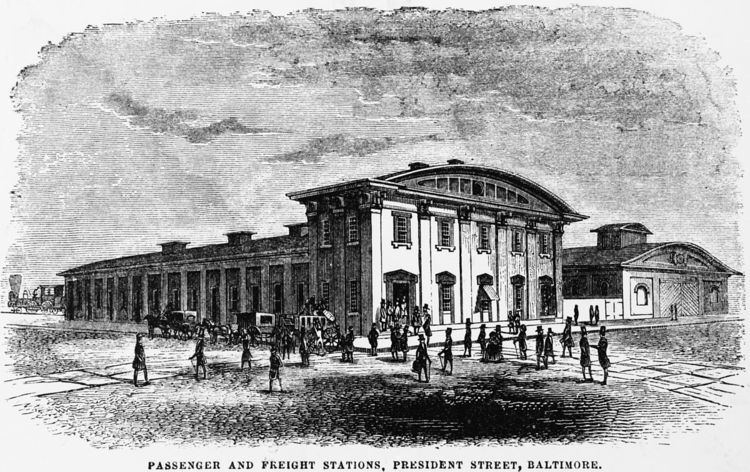Area less than one acre NRHP Reference # 92001229 Phone +1 443-220-0290 Added to NRHP 10 September 1992 | Built 1849 (1849) Opened 1849 Restored 1997 | |
 | ||
Address 601 S President St, Balti, MD 21202, USA Hours Open today · 10AM–4PMSunday10AM–4PMMondayClosedTuesdayClosedWednesdayClosedThursdayClosedFridayClosedSaturday10AM–4PMSuggest an edit Similar Star‑Spangled Banner Flag House, National Katyń Memorial, Camden Station, Balti Public Works Mu, Phoenix Shot Tower | ||
The thumbs president street station 1 1 10 charm city art space baltimore md
The President Street Station in Baltimore, Maryland, is a former train station. Built in 1850, the station was an important rail transportation link during the Civil War. Today, it is the oldest surviving big-city railroad terminal in the United States and is home to the Baltimore Civil War Museum.
Contents
- The thumbs president street station 1 1 10 charm city art space baltimore md
- History
- Post railroad use
- As a museum
- References
History
The Baltimore and Port Deposit Rail Road (B&PD), founded in 1832, completed a rail line from Baltimore to the western shore of the Susquehanna River in 1837. The railroad’s Baltimore terminus was on the east side of the "Basin," now known as the Inner Harbor, at the southern end of President Street. The B&PD exchanged freight cars with the Baltimore and Ohio Railroad (B&O), which had built a track (along Pratt Street) to the east Basin area from its original Mount Clare depot on the western side of the business district. The B&PD and its successor company, the Philadelphia, Wilmington and Baltimore Railroad (PW&B), transferred passengers to the B&O downtown depot at Pratt and Charles streets by a horse-drawn car on B&O's connecting track. (The city prohibited the operation of locomotives on this track.) By 1838, the PW&B was carrying passengers from Philadelphia to Baltimore, where they could transfer to the B&O and continue to Washington, D.C.
The PWB started building its own station at President Street in 1849. The Greek Revival-style station opened on February 18, 1850. In addition to the brick head house, the original station also had a 208 feet (63 m) long barrel vaulted train shed over the tracks. The PW&B added a freight house, to the south of the passenger station, in 1852.
The station was involved in the Baltimore riot of 1861, when Massachusetts troops bound for Washington were marching to the B&O Camden Station ten blocks west and were attacked by an angry mob of Southern sympathizers, with several people killed in the ensuing melee.
In 1873, the Union Railroad built a new set of tracks in Baltimore, connecting the original PW&B main line with the Northern Central Railway (NCRY). The new connection ran through Union Tunnel to NCRY’s new Charles Street Station. (This station was rebuilt twice, as "Union Station" and ultimately "Pennsylvania Station".) Charles Street Station and its successors largely replaced the President Street Station for passenger service. The latter continued to serve as a freight station, but served some passenger trains until 1911. The Pennsylvania Railroad, which acquired the PW&B in 1881, demolished the President Street train shed in 1913 and erected a new, shorter shed, built with wooden trusses.
Post-railroad use
The President Street Station was later used as a warehouse. The train shed was destroyed by fire, leaving only the present head house by 1970, when it was abandoned. In 1979, the derelict building was acquired by the City of Baltimore, which planned to demolish it to clear the way for a proposed extension of Interstate 83, which was never built. In 1989, the station’s wooden arched roof collapsed in a snowstorm.
As a museum
In the 1990s, a public-private partnership funded the restoration of the vacant station, which reopened in 1997 as the Baltimore Civil War Museum. President Street Station, Inc. operated the museum until 2000, when the building lease was taken over by the Maryland Historical Society (MHS). The lease expires in 2017. The museum closed in 2007, then re-opened on weekends only, operated by MHS and subsequently by volunteers from the Friends of President Street Station. The Civil War Museum was open on weekends in February 2010, in observance of Black History Month, although heavy snowfall forced closure of the museum on two weekends.
The future of the historic property is uncertain: the City of Baltimore announced plans in 2009 to designate the old depot as a landmark, which would restrict modifications to the building's exterior. But plans by the city to advertise a request for proposals (RFP) in 2009 for commercial development of the grounds are opposed by the Friends of the President Street Station group. They have called instead for the station's preservation and management as a museum by the National Park Service (NPS). The director of Baltimore's Commission for Historical and Architectural Preservation, which will review the RFP responses, told the Baltimore Sun that any commercial use "must be subordinate to the history" and that a multi-use partnership would be ideal for better use of the building.
On February 13, 2015, U.S. Senators Barbara Mikulski and Benjamin Cardin introduced bill S
